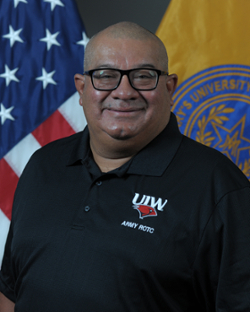Army ROTC
The University of the Incarnate Word, in conjunction with the Armed Forces of the United States, is proud to participate in several collaborative programs with the Reserve Officer Training Corps. Through these agreements students may earn credit and additional scholarship opportunities while serving their country.
The Army maintains a senior Reserve Officer Training Corps (ROTC) program at the University of the Incarnate Word (UIW) and St. Mary's University. UIW students interested in participating in Army ROTC may do so through the cross-enrollment agreement between St. Mary's and UIW. Four-year and two-year programs are available to eligible students.
Military science classes are held at both St. Mary's University and the University of the Incarnate Word. Classes are held on Mondays, Tuesdays and Wednesdays, and all military science classes include a leadership lab requirement. The leadership lab is a two-hour course taught every Wednesday from 3 - 5 p.m., and the labs are generally held at the St. Mary's University campus. The leadership lab is intended to supplement classroom instruction and focuses on development of individual leadership skills through field training, practical exercises and visits to military installations.
Four-Year Program
The Basic Course, usually pursued during the freshman and sophomore years, is voluntary for students who are physically qualified for military training. There is no obligation incurred unless the student accepts an ROTC scholarship. Veterans who have completed Army basic training (or sister service equivalent) and who have received an honorable discharge, or high school students who have completed three or four years of high school JROTC may be granted credit for the basic course with approval of the St. Mary's professor of military science.
The Advanced Course may be pursued by students who are physically and academically qualified. Cadets are normally enrolled in the Advanced Course during their junior and senior year or during graduate school. Students are required to attend a four-week ROTC Advanced Camp the summer following the junior year. Upon satisfactory completion of Advanced Camp and the academic work required for a degree, students are commissioned as second lieutenants in the United States Army, the Army Reserve or the Army National Guard.
Two-Year Program - Advance Course
In addition to the standard four-year course outlined above, the St. Mary's University Military Science Department offers a two-year program for those who did not complete the Basic Course. In order to enroll in the Advanced Course, a student must successfully complete four weeks of leadership training provided at Basic Camp in Fort Knox, KY during the summer months prior to beginning the junior year or the first year of graduate school. If students desire to take advantage of this opportunity, they should communicate directly with the St. Mary's University enrollment officer no later than March 1 of the year preceding the last two years of college. Those students seeking a master's degree or a law degree are eligible to participate in the two-year program.
Scholarship and Remuneration
The Army offers four, three and two-year competitive scholarships. This assistance consists of payment up to $50,000 per year to cover tuition and fees, a $1,200 per year book stipend and a monthly stipend of $420 per month. Additionally, students are paid for all required summer training. The student need NOT be enrolled in the ROTC program to apply for a scholarship. Students interested in competing for scholarship assistance should contact the UIW Army ROTC enrollment officer at (210) 832-3210.
Army Nurse Corps
As a ROTC nursing student, you'll be able to combine college electives in military science, and an invaluable summer clinical experience, with your regular nursing program. You will develop your professional and leadership skills while learning about yourself and what you can accomplish. Check here for additional information: Army ROTC for Nursing Students.
Uniform and Equipment
All uniforms, textbooks and other equipment will be issued, free of charge, to students enrolled in Army ROTC courses.
LTC James Nance, Professor of Military Science
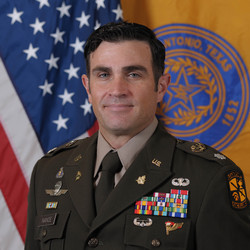
jnance1@stmarytx.edu
Lieutenant Colonel (LTC) James "Justin" Nance, a native of southern and eastern New Mexico, received his commission from the Early Commissioning Program at the New Mexico Military Institute in 2006. LTC Nance's first assignment was in the Texas Army National Guard; he served as a platoon leader in Headquarters and Headquarters Company, 2nd Battalion 142nd Infantry Regiment, while finishing his Bachelor of Science in Biology from Texas Tech University.
LTC Nance transitioned to Active Duty in 2009, attended the Basic Officer Leaders Course, and was assigned to the 101st Airborne Division (Air Assault) Fort Campbell, KY. There he served as Company Executive Officer in the Division Headquarters Battalion and deployed to Afghanistan in support of Operation Enduring Freedom X. Upon redeployment, LTC Nance attended the Captain's Career Course while completing his Master of Science Degree in Geological Engineering from Missouri University of Science and Technology.
LTC Nance's first assignment following the Civil Affairs Qualification Course was as Team Leader for CAT 8025 in the 80th Civil Affairs Battalion at Fort Bliss, TX. He was stationed at Fort Hood in 2015 as the 1st Brigade (Iron Horse) Civil Affairs Officer (S9) with the 1st Cavalry Division. He deployed in support of the Republic of Korea Rotation before taking command of one of the few Army Ceremonial Units, the Horse Cavalry Detachment. There LTC Nance led over 200 mounted cavalry demonstrations across the United States. Following command and resident graduation from the Command and General Staff College at Fort Leavenworth, Kansas. LTC Nance returned to Fort Campbell as the 101st Airborne Division (Air Assault) Deputy Civil Affairs Officer (G9). In 2020, LTC Nance deployed in support of Operation Inherent Resolve as the SOJTF-OIR Deputy Future Plans Officer (J35) before assuming command and deploying Echo Company, 96th Civil Affairs Battalion (Special Operations) (Airborne) to the Levant in support of the same named operation. Upon redeployment he was assigned as the Battalion Executive Officer, 92nd Civil Affairs Battalion (Special Operations) (Airborne) and most recently as the Operations Officer for the Office of Special Warfare, 1st Special Forces Command (Airborne).
LTC Nance's military education includes the Chemical Officer Basic Course; Engineer Captains Career Course; the Civil Affairs Qualification Course; Special Operations Language Course-Modern Standard Arabic; Survival, Escape, Resistance, Evasion-C; and the Command and General Staff College at Fort Leavenworth, KS. His awards include the Bronze Star Medal, Meritorious Service Medal (2OLC), Joint Service Commendation Medal (1OLC), Army Commendation Medal (2OLC), Joint Meritorious Unit Medal (1OLC), Parachutist Badge, Air Assault Badge, Pathfinder Badge, Army Space Badge, Gold German Armed Forces Badge of Military Proficiency, and Italian Foreign Jump Wings.
LTC Nance is married to the lovely Major Chelsea Nance with U.S. Army Reserves and has two daughters, Hazel (3) and Cora (2).
CPT Bryan Nematpour, Assistant Professor of Military Science
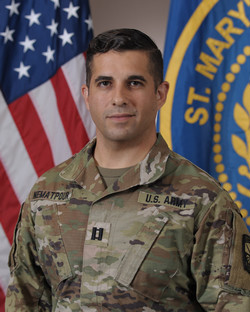 210-436-3011, ext 4375
210-436-3011, ext 4375nnematpou@stmarytx.edu
CPT Bryan Nematpour was born in Houston, TX and joined the Army in 2006 as a 12Y Geospatial Engineer. During his enlistment he was assigned to the 1st Armor Division Headquarters, out of Wiesbaden Germany. He deployed twice to Iraq during Operation Iraqi Surge and New Dawn. He was later reassigned to Central Command Headquarters Joint Intelligence Center, out of MacDill Air force Base, Tampa, FL. He served there as the J2 Geospatial Intelligence Team Senior Sergeant.
In 2012 CPT Nematpour was accepted into the Green to Gold program with the University of South Florida Army ROTC and earned a Bachelor of Science in Leadership and Organizational Management as well as his commission as an active-duty Armor Officer. He completed the Armor Basic Officer Leader Course, Army Reconnaissance Course, and Stryker Leader Course in 2014 and was assigned to 2-1 Cavalry Squadron, 4ID where he assumed a variety of tactical leadership positions. As a branch detailed Officer CPT Nematpour attended the Adjutant General Captain’s Career Course in 2018 and was subsequently assigned to the 1st Aviation Brigade, Fort Novosel, AL to serve as the Brigade S1. While stationed in AL CPT Nematpour earned a Master of Public Administration in Human Resource Management before being reassigned to 5th Senior ROTC Brigade, Fort Sam Houston, TX where he served again as the Brigade S1. He currently serves as the Assistant Professor of Military Science for Saint Mary University ROTC.
CPT Nematpour’s assignments include Mortar Platoon Leader, C/2-1CAV, 1SBCT/4ID
Fort Carson, CO; Scout Platoon Leader, C/2-1CAV, 1SBCT/4ID Fort Carson, CO; Squadron S1 OIC, HHT/2-1CAV, 1SBCT/4ID; Brigade S1 OIC, 1st Aviation Brigade/USAACE Fort Novosel, AL; Brigade S1 OIC, 5th Senior ROTC Brigade/USACC Fort Sam Houston, TX. He has deployed in support of Operation Iraqi Surge and New Dawn.
CPT Nematpour currently resides in San Antonio, TX with his family. He is married to Eryka Nematpour and together they have three sons, Evan, Emmett, and Tobias Nematpour.
Awards and Decorations
CPT Nematpour’s awards and decorations include the Meritorious Service Medal (1OLC), Joint Service Commendation Medal, Army Commendation Medal (2 OLC), Army Achievement Medal (2 OLC), the National Defense Service Medal, the Iraqi Campaign Medal (1OLC), the Global War on Terrorism Service Medal, the Army Service Ribbon, Army Overseas Service Ribbon (2 OLC), the NCO Professional Development Ribbon, the Meritorious Unit Commendation (1OLC), and Honorable Order of Saint George Medal.
MSG Joseph Hunter-Smith, Senior Military Instructor
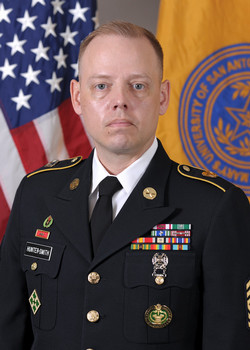 (210) 436-3415, ext. 1522
(210) 436-3415, ext. 1522
jhuntersmith@stmarytx.edu
MSG Joseph Huntersmith is from Central PA. His military occupational specialty (MOS) is 13Z, Field Artillery Senior Sergeant. He enlisted in the Army on 28 July 2005 and attended One Station Unit Training (OSUT) at Fort Sill, Oklahoma where he was awarded the primary MOS of 13B, Cannon Crewmember.
MSG Smith’s assignments include Cannoneer Number One and Gunner with B Btry, 2nd Battalion, 77th Field Artillery, Fort Hood, TX; Gunner, Team Leader, Squad Leader, and Howitzer Section Chief with B Btry, 5th Battalion, 82nd Field Artillery, Fort Hood, TX; Senior Drill Sergeant with 1st Battalion, 79th Field Artillery, Fort Sill, OK; Platoon Sergeant with B Btry, 2nd Battalion, 11th Field Artillery, Schofield Barracks, HI; Equal Opportunity Program NCOIC for 25th Infantry Division and US Army Hawaii, Schofield Barracks, HI, First Sergeant of B Btry, 2nd Batallion, 82nd Field Artillery Regiment, Fort Cavazos, TX. He most recently served as the First Sergeant of HHB, 2nd Batallion, 82nd Field Artillery Regiment, Fort Cavazos, TX. His deployments include Operation Iraqi Freedom 05-06, Operation Iraqi Freedom 08-09, Operation New Dawn 10-11, and Operation European Assure, Deter, and Reinforce 22-23.
MSG Smith’s military education includes Basic Leaders Course, Advanced Leaders Course (Distinguished Honor Graduate), Senior Leaders Course, Master Leaders Course (Distinguished Honor Graduate), Drill Sergeant School, Equal Opportunity Advisor Course, Field Artillery Weapons Maintenance Course, Small Arms Weapons Expert Course, Master Resiliency Trainer Course, Combatives Level 1, Army Basic Instructor Course, Company Commanders/First Sergeant Pre-Command Course, and Combat Lifesavers Course.
MSG Smith’s awards and decorations include the Meritorious Service Medal (2 OLC), Army Commendation Medal (5 OLC), Army Achievement Medal (5 OLC), National Defense Service Medal, the Global War on Terror Service Medal, Iraq Campaign Medal (5 Campaign Stars), NCO Professional Development Ribbon (Number 4), Overseas Service Ribbon (Number 4), and Drill Sergeant Identification Badge. He is a recipient of the Honorable Order of Saint Barbara.
SFC Zachariah Oeland, Military Science Instructor
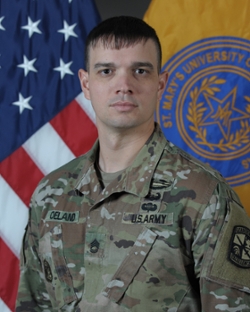 (210) 832-3210
(210) 832-3210
rotc@uiwtx.edu / oeland@uiwtx.edu
Office: NB #146
Sergeant First Class Zachariah P. Oeland enlisted in the Army in 2006 and attended One Station Unit Training as an 11B (Infantryman) at Fort Benning, Georgia. His initial assignment was to the 1st Squadron, 33rd Cavalry Regiment, 3rd Brigade Combat Team, 101st Airborne Division, out of Fort Campbell, Kentucky, where he served as a Squad Automatic Rifleman.
In September, 2007, Oeland was deployed in support of Operation Iraqi Freedom. Upon redeployment, he was promoted to the rank of Sergeant and served as a Sniper and Team Leader. In January 2010, he deployed in support of Operation Enduring Freedom where he was awarded an Arcom with Valor Device.
Upon redeployment in 2011 he was promoted to the rank of Staff Sergeant and assigned to 1st Battalion, 36th Infantry Regiment (Stryker), with the 1st Brigade, 1st Armored Division out of Fort Bliss, Texas, where he served as a Squad Leader as well as deploying a second time in support of Operation Enduring Freedom. In 2014, SSG Oeland was selected to serve as a Drill Sergeant and later Senior Drill Sergeant at Fort Jackson, South Carolina, with the 3rd Battalion, 34th Infantry Regiment from 2015 to 2017.
In 2017, SSG Oeland was reassigned to the 1st Squadron, 11th Armored Cavalry Regiment, in Fort Irwin, California, where he served as a Platoon Sergeant and promoted to Sergeant First Class in 2018. SFC Oeland is currently assigned as a Military Science Instructor at St. Mary’s University in San Antonio, Texas.
His military education includes: Senior Leader Course (CL), Advanced Leader Course, Basic Leader Course, Drill Sergeant Course, Battle Staff Course, Sexual Harassment/Assault Response Prevention Course, Master Resilience Training Course, Sniper School, Airborne School, Air Assault School, NTC Observer/ Controller Course, Combatives Level 1, Armorer Course, Field Sanitation Course, Sling Load Inspection Certification Course, Anti-Terrorism Basic Course
SFC Oeland has been married to Cortney Oeland since 2006, and they share two children together, a son, Gavin, and a daughter, Paislee.
Awards
His awards and decorations include: Order of Saint Maurice (Legionnaire), Purple Heart, Meritorious Service Medal (2nd award), Army Commendation Medal with Valor Device, Army Commendation Medal (5th award), Army Achievement Medal (4th award), Valorous Unit Award, Meritorious Unit Citation (2nd award), Army Superior Unit Award, Army Good Conduct Medal (4th award), National Defense Service Medal, Afghanistan Campaign Medal (two Bronze Service Stars), Iraqi Campaign Medal (one Bronze Service Star), Global War on Terrorism Service Medal, NCO Professional Development Ribbon (3rd award), Army Service Ribbon, Overseas Service Ribbon (2nd award), NATO Medal, Combat Infantryman’s Badge, Expert Infantryman’s Badge, Drill Sergeant Badge, Parachutist Badge, Air Assault Badge, Driver/mechanic Badge (Wheeled), Certificate of Achievement (3rd award).
CIV Chez Varela, Assistant Professor of Military Science/Recruiting Operations Officer
(210) 436-3011, ext. 1517
cvarela@stmarytx.edu
After service as an Air Force Space Command Communications Noncommissioned Officer, Retired Air Force Captain Augustine Varela Jr. entered the Reserve Officer Training Corps at University of Nebraska-Omaha. He was commissioned in 1990 and graduated with a Bachelor of Arts in Criminal Justice. Varela is a graduate of the Signal Corps Officer's Basic Course, Signal Corps Advance Course, Combined Arms Services Staff School (CAS3), Commander's Course and the Observer/Controller Trainer (OC/T) Course.
His military assignments include: Cable Platoon Leader in Desert Storm/Desert Shield; Tactical Satellite Platoon Leader; Company Executive Officer; G6 Telecommunication Staff Officer for the 22nd Signal Brigade, V Corps; S6, 297th Military Intelligence Battalion,
Fort Gordon, Georgia; Allied Military Intelligence Battalion, NATO Headquarters, Sarajevo, Bosnia; Company Commander, Charlie Company, 447th Signal Battalion, Fort Gordon, Georgia; Active Component / Reserve Component (AC/RC) Operations Officer, 75th Training Support Division, Houston; and Chief, J6 Operations, Exercise, and Training Branch for NATO Joint Headquarters, Madrid, Spain. He is currently the Recruiting Operations Officer for St. Mary's University.
Awards
His awards and decorations include: Meritorious Service Medal, Joint Service Commendation Medal, Army Commendation Medal (Three Oak Leaf Clusters), Air Force Commendation Medal, Joint Service Achievement Medal, Army Achievement Medal, Air Force Outstanding Unit Award, Air Force Good Conduct Award, National Defense Service Medal, Armed Forces Expeditionary Medal, Southwest Asia Service Medal (Three Campaign Stars), Kosovo Campaign Medal, Armed Forces Service Medal, Air Force NCO Leadership Ribbon, Army Service Ribbon, Overseas Service Ribbon, Air Force Training Ribbon, NATO Medal, Southeast Kuwait Liberation Medal, and the Kuwait Liberation Medal.
Varela resides in San Antonio and has one daughter, Augustina.
Mr. Frederick Nash, Human Resources Assistant
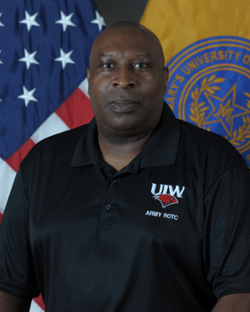 (210) 832-3210
(210) 832-3210
fnash@uiwtx.edu
Frederick Nash was born and raised in Colfax, LA, graduated from Montgomery High School in May 1990.
Following in his family's footsteps, he enlisted into the U.S. Army on October 1990 as an (11M) Mechanized Infantry Soldier and completed basic training and Advanced Individual training at Fort Benning Georgia, “Home of the Infantry”.
His previous assignment positions and deployments include: 5th Battalion 15th Infantry Regiment Schweinfurt Germany; 1st Battalion 5th Calvary Regiment Fort Hood, TX; 1st Battalion 26th Infantry Regiment Schweinfurt Germany; with deployments to Bosnia, Macedonia, and Kosovo; 1st Battalion 15th Infantry Regiment Fort Benning GA; 2nd Battalion 9th Infantry Regiment South Korea (Camp Casey); Noncommissioned Officer Academy Fort Benning, GA (Primary Leadership Development Course); 2nd Battalion 11th Infantry Regiment Fort Benning, GA (Infantry Officer Basic Course); Operation Group National Training Center, Fort Irwin, CA (Scorpion Team); 1st Battalion 37th Armor Regiment Fort Bliss, TX with deployments to Iraq; 3rd Battalion 41st Infantry Regiment Fort Bliss, TX; San Diego State University, San Diego, CA (Senior Military Science Instructor).
Mr. Nash has held numerous positions ranging from Rifleman, Team Leader, Squad Leader, Section Leader, Platoon Sergeant, and Company First Sergeant. He is currently serving as the human resource assistant for St. Mary's University and the University of the Incarnate Word ROTC.
His military education includes: Combat Life Savers Course, Primary Leadership Development Course, Basic Noncommissioned Officer Course, Advanced Noncommissioned Officer Course, Unit Prevention Leader Course, Senior Instructor/Writer Course, Total Army Instructor Training Course, Combative Level 1 Course, Senior Military Science Instructor Course, and First Sergeants Course.
Mr. Nash is married to the former Bridgett Williams of Colfax, Louisiana. They have three sons, Brandon, Caleb and Cameron.
Awards
His awards and decorations include: Bronze Star Medal, Meritorious Service Medal (2), Army Commendation Medal (5), Army Achievement Medal (6), Army Good Conduct Medal (8), National Defense Service Medal with 1 star, Iraqi Campaign Medal, Global War on Terrorism Service Medal, Korean Defense Service Medal, Noncommissioned Officer Professional Development Ribbon (3), Army Service Medal, Overseas Service Ribbon (3), and the Expert Infantry Badge.
Mr. Charles Holland, Human Resources Assistant
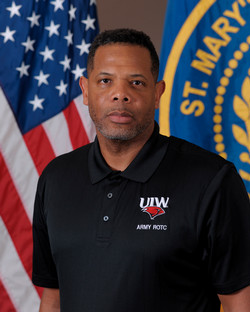 (210) 832-3210
(210) 832-3210
cholland@stmarytx.edu
Ms. Tina Smith, Logistics Technician
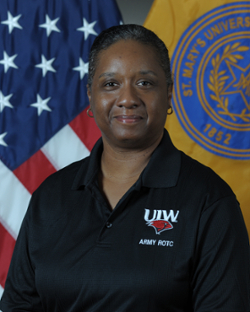 (210) 436-3145, ext. 2153
(210) 436-3145, ext. 2153
tsmith26@stmarytx.edu
Reserve Officer Training Corps, or ROTC, combines courses in military science with summer training opportunities focused on transforming college students into the Army leaders of tomorrow as commissioned officers. The classes are available at hundreds of colleges and universities throughout the nation.
Freshman and Sophomore Years
During the freshman and sophomore years of college, cadets tackle the Basic Course, which includes topics like Army Values, first aid, basic land navigation, time management, goal setting, and military customs and courtesies. There is a constant emphasis on leadership development and Cadets begin their initial introduction to military tactics – the vehicle that is used to assess their leadership growth and potential. Through these two first years, cadets typically take these classes as electives and do not have to make a commitment to serve in the Army.
Junior and Senior Years
During the final two years of ROTC, called the Advanced Course, cadets continue to refine their abilities to lead at the squad and platoon level. They learn about Army Leader Ethics, the Army Profession, advanced land navigation skills, and participate in labs that continue to facilitate their leadership development. During the Advanced Course, cadets will not only lead teams through tactical situations, they begin to teach, coach and mentor other cadets on how to accomplish those tasks. The Advanced Course is the first point at which most cadets must make a commitment to serve.
For students who did not take ROTC during their first two years of college, a compressed version of the Basic Course is available each summer. This 4-week training session, called Basic Camp, gives students a condensed version of the subjects normally taught on campus during the first two years of ROTC.
Upon Graduation
The reward for all the hard work comes on graduation day — when cadets leave their alma mater as second lieutenants in the U.S. Army. Many of these newly commissioned officers will immediately begin service in the Army. Others, will fulfill their military obligation as citizen-soldiers, through service in the Army National Guard or the Army Reserve.
Visit the official Army ROTC webpage for further information.
What We Offer
UIW Army ROTC presents students with the opportunity to learn and grow in a variety of ways. The program of instruction challenges each cadet in the battalion in both indoor and outdoor settings; cadets participate in classroom instruction while also engaging in world class physical fitness training, land navigation, marksmanship, rappelling, and other military activities. Cadets learn management and leadership skills not available in other University programs. They are also allowed the opportunity to participate in a broad spectrum of internships around the world and to attend Airborne and Air Assault training.
The Experience
Army ROTC experience contributes to a variety of job skills applicable to any profession, career or job, while instilling in each cadet a sense of confidence, discipline, and personal responsibility. Moreover, each cadet gains the satisfaction of being part of a select group of great Americans dedicated to American values and service to the nation.
To Commission as an Army Officer
There are many routes you can take to commission as a second lieutenant through Army ROTC. You can enter our program as a freshman, sophomore, or once you have at least two years remaining at UIW as an undergraduate or graduate student.
The Cardinal Company
UIW Army ROTC is a great place to start either for a few years or a full career in uniform, but whatever you do, Army ROTC will teach you le adership excellence for a lifetime.
Although ROTC is a military oriented program, the value of its training is recognized by business leaders. Studies have shown that ROTC graduates have a definite advantage when seeking employment in the civilian sector of the economy.
Specialty Teams
Ranger Challenge
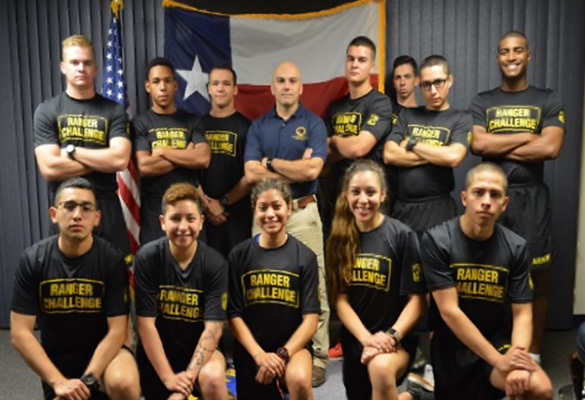 Ranger Challenge (RC) is the Varsity sport of ROTC. It is a team based event that tests the mental and physical toughness of all participants. Competing as members of a team, Cadets are tested on Land Navigation, weapons assembly and disassembly, marksmanship, one-rope bridge assembly and crossing, the Army Physical Fitness Test, and numerous other physically challenging tactical tasks.
Ranger Challenge (RC) is the Varsity sport of ROTC. It is a team based event that tests the mental and physical toughness of all participants. Competing as members of a team, Cadets are tested on Land Navigation, weapons assembly and disassembly, marksmanship, one-rope bridge assembly and crossing, the Army Physical Fitness Test, and numerous other physically challenging tactical tasks.
To become part of the Rattler Ranger Challenge team, cadets undergo a rigorous training and selection process. This process ends with the selection of the RC team and a semester-long training evolution to prepare for the regional, brigade, and national competition.
Bataan
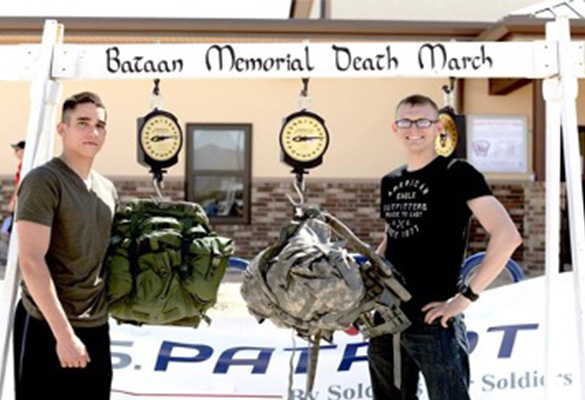
“26 MILES OF HIGH DESERT, 26 MILES OF PURE PERSEVERANCE”
Bataan is a memorial march in honor of the heroes who defended the Philippine Islands during World War II. It is a challenging march through the high desert terrain of the White Sands Missile Range.
Army Ten Miler
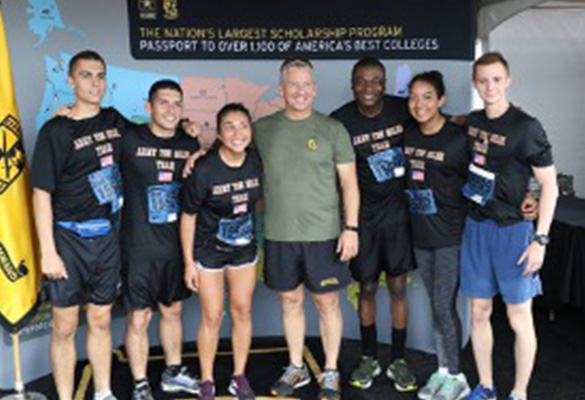 Every fall, the Cardinal Company participates in the Army Ten Miler Race in Washington D.C. The race runs around some of our nation's most famous monuments.
Every fall, the Cardinal Company participates in the Army Ten Miler Race in Washington D.C. The race runs around some of our nation's most famous monuments.
Specialty Schools
Airborne Training
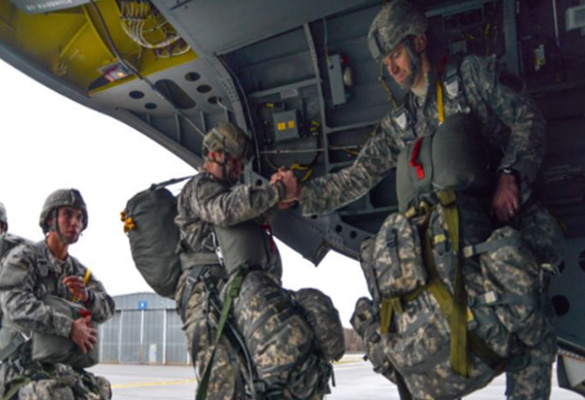
The U.S. Army Airborne School, located at Fort Benning, Georgia, is available to cadets that are enrolled in the program. The course is three weeks long, consisting of a ground week and jump week. With each week comes different types of training designed to teach you how to parachute out of airplanes and helicopters. It is an exciting, nonstop course that will push you to the limit.
Air Assault Training
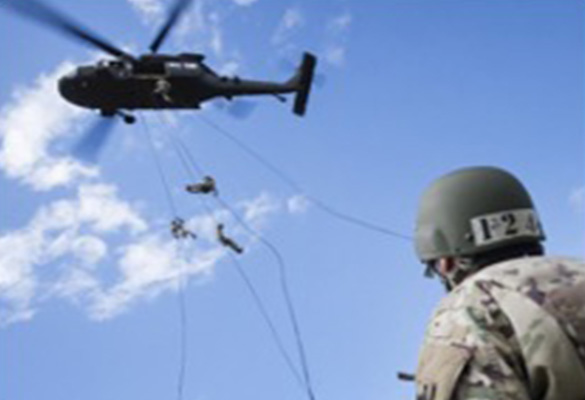
Air Assault Training is available at different Army posts across the country. It is a 10- to 12-day course consisting of physical training, sling load training, rappelling, and a 12-mile timed road march in full combat gear. This is a tough course that will exhaust you both physically and mentally, but in the long run it will be worth everything you put into it!
German Proficiency Badge 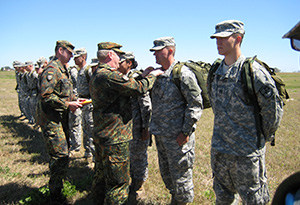
The German Armed Forces Badge for Military Proficiency is a decoration of the Bundeswehr , the armed forces of the Federal Republic of Germany. The decoration is awarded to and worn by German service members of all ranks. Allied service members may also be awarded the badge, subject to their nations' uniform regulations. In the United States Army, 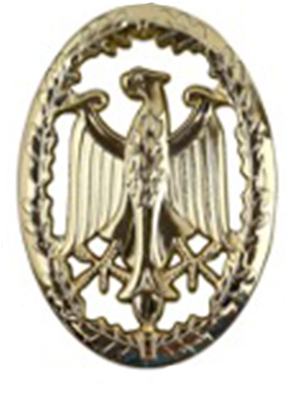 the German Armed Forces Badge for Military Proficiency is one of several hundred foreign awards approved for wear on the uniform. To Earn the Award one must complete the following requirements: Evaluation Report; First Aid Course; NBC Test, Basic Fitness Test; Marksmanship; Foot March with 33lb Rucksack; and complete an 100 Meter swim in Military Uniform.
the German Armed Forces Badge for Military Proficiency is one of several hundred foreign awards approved for wear on the uniform. To Earn the Award one must complete the following requirements: Evaluation Report; First Aid Course; NBC Test, Basic Fitness Test; Marksmanship; Foot March with 33lb Rucksack; and complete an 100 Meter swim in Military Uniform.
Northern Warfare Training
Northern Warfare Training Center (NWTC) – Filling the need for special arctic warfare training is the United States Army's NWTC. An exclusive school that provides training in arctic survival, navigation of land and waterways, military skiing, mountaineering and river crossing operations. The school trains not only active duty soldiers but soldiers from other services, reserve soldiers, ROTC, West Point cadets and allied military soldiers. Emphasis during the summer is placed on mountain warfare while the winter months are used to train soldiers on how to adapt to living in the field, clothing use and maintenance, as well as snowshoeing and military skiing. NWTC is also the home of the Army Mountaineering Team. Each year the team joins soldiers from allied countries to attempt a multinational friendship climb up Mount McKinley.
Norwegian Foot March Badge 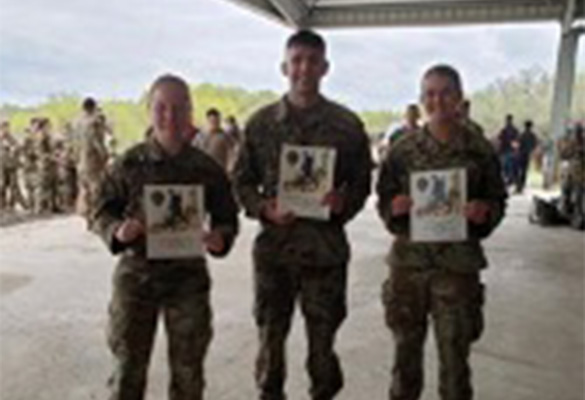
The Norwegian Foot March, or Marsjmerket, is a Norwegian armed forces skill badge that is earned. It originated in 1915 for the purpose of exposing civilians and new military recruits to what it is like to be in the field. Since then, it has evolved to become a Foreign Service badge earned by completing the foot march to standard. Participants had to complete, in uniform with boots, an 18.6 mile (30 kilometers) ruck march within 4 hours and 30 minutes while carrying a 25 pound (11 kilograms) ruck sack. Participants had to abide by the rules in order to earn the badge.
The ruck march is sponsored and verified by a member of the Norwegian Army. The Norwegian Foot March badge is an approved foreign award and may be worn on the Army Service Uniform.
"Physical fitness is paramount in a Soldier's career," said CDT Kujawa. "The ruck hurt, but the cadets and cadre the Rattler Battalion pushed through and earned a foreign badge."
Mountain Warfare Training
Mountain Warfare School is a two-week course conducted at the Ethan Allen Firing Range at Jericho, Vt. Both a summer and a winter phase are offered. Its mission is to develop and conduct resident mountain warfare training under both summer and winter conditions. The mountain warfare course develops the leadership and technical skills of Army personnel by requiring them to perform mountaineering tasks in a realistic tactical mountain environment. It provides the student with the practical hands-on experience in the application of tactics and techniques needed for mountain operations.
Cadet Troop Leader Training (CTLT)
CTLT increases each cadet's leadership experience. Each cadet is assigned to a platoon leader position and given an opportunity to lead soldiers. It familiarizes cadets with the command, training, administration and logistical functions of active duty units. It also exposes cadets to the on-duty and off-duty environment of the junior officer.
Airborne/Air Assault/Mountain Warfare/Scuba School
![]()
![]()

Additional training:
- CTLT
- CULP
Green to Gold
The Green to Gold Active Duty option program provides eligible, active duty enlisted soldiers an opportunity to complete a baccalaureate degree or a two-year graduate degree and earn a commission as an Army Officer. The deadline for submission of Green to Gold ADO and Scholarship Applications will be determined upon opening of the application window. Learn more about the Green to Gold Active-Duty Option Program.
Simultaneous Membership Program
The Simultaneous Membership Program (SMP) allows you to participate in ROTC and enlist in the Army National Guard or Army Reserve at the same time, provided a vacancy exists in either a Guard or Reserve unit. While you're still in college, you can be gaining valuable experience and earning extra income.
You'll serve as an officer trainee in a Guard and Reserve unit and perform duties commensurate with the grade of second lieutenant. Once you graduate and are commissioned, you may continue your military service with your unit or apply for active duty.
The SMP is a volunteer officer training program that allows Army National Guard and Army Reserve enlisted members to also participate in the Advanced ROTC Program. Upon completion of Basic Training, a Reserve Component Soldier who is an academic junior, can join the Advanced ROTC program and earn a commission as an officer in the United States Army while completing their college degree. In addition, contracted non-scholarship cadets and Reserve Forces Duty (RFD) scholarship cadets can join a Reserve Component unit and the SMP. The intent of the SMP is to increase officer accessions into the Reserve Components (RC) by increasing ROTC enrollment from enlisted RC members who are attending college.
The SMP Provides:
- Future Reserve and Active Duty officers
- A Guaranteed Reserve Forces Duty (GRFD) Scholarship option
- An opportunity for Guard and Reserve units to select future Reserve officers
- ROTC cadets who can assume officer responsibilities while serving in Reserve Component units
What is SMP to the Individual?
- An opportunity to gain a commission while going to college and to serve in a Reserve Component Unit
- Hands-on management and leadership training
- A ROTC stipend plus E-5 pay while at drill
- Annual Training pay
- Montgomery GI Bill and Tuition Assistance
- An opportunity to win a three-year GRFD Scholarship
- A future as an officer on Active Duty or Reserve Duty
- Opportunity for volunteer training in Airborne, Air Assault, Northern or Mountain Warfare Training
Who is Eligible?
- Has completed Basic Training or equivalent
- Has a sophomore or junior standing at his/her school
- Is physically qualified
- Is under 30 years of age when commissioned (waiverable through age 34)
- Nursing students have to be less than 41 by December 31st of your graduation year
- Has a 2.0 GPA on a 4.0 grade scale
- Has four years left on current military obligation
- Is a full-time student
- U.S. citizen
What is the Commitment Upon Commissioning?
Upon completion of the ROTC program, the officer has an eight-year obligation which can be served in the Reserve Forces, on Active Duty, or a combination of the two.
GRFD Scholarship and Non-Scholarship Option
The GRFD Program is designed to attract cadets who are interested in obtaining a commission in the Army National Guard (ARNG) or the U.S. Army Reserve (USAR).
The GRFD Program also allows cadets to make a statement of early individual preference for Reserve Force Duty (RD). Those who satisfactorily participate are guaranteed to receive a RD duty assignment during the accession process. If a Non-Scholarship cadet becomes interested in active duty, they may request to revoke their GRFD contract endorsement and compete for active duty during the accession process. Use of this program will enable the Army ROTC Program to continue to meet its active duty (AD) requirements while providing officers for the Reserve Components (RC).
Since the intent of the GRFD Program is to encourage interest in the RC, satisfactory participation in the Simultaneous Membership Program (SMP) is required of all GRFD cadets.
For general scholarship information, visit goarmy.com/rotc.View more about the History of Army ROTC at St. Mary's University.
The St. Mary's University Army Reserve Officer Training Corps program, established in 1932, has commissioned 1,705 officers as of September 2020 for our Army.
Prior to the National Defense Act of 1916, military training occurred primarily at land grant institutions established by the Morrill Act of 1862. The Morrill Act stipulated that each land-grant institution would provide instruction in military tactics as part of its engineering and agriculture curriculum. When the Civil War ended in 1865, the benefits of the Morrill Act were extended to former Confederate States of America, including Texas, thus allowing for the creation of the Agricultural and Mechanical College of Texas, now Texas A&M University, in 1876. From 1876 until World War I, formal military instruction was generally only available at the major state-funded institutions of Texas (Texas A&M and the University of Texas), and even at those schools, it was not formalized under U.S. Army control until 1916.
The National Defense Act of 1916 formalized the establishment of Reserve Officers Training Corps programs at civilian colleges and universities throughout the U.S. Immediately following the NDA and in the feverish effort to produce men and materiel for the war effort in Europe, the War Department selected 28 Texas colleges and universities to participate in the Students Army Training Corps (SATC) program. Approved by Congress on Aug. 31, 1918, the SATC program was an agreement between the U.S. Department of War and American educators to prevent the U.S. Department of War's conscription efforts from further depleting the number of 18-year-old males entering universities in the fall of 1918. The only SATC program available in San Antonio was at the West Texas Military Academy, the predecessor to the Texas Military Institute. The SATC program was short-lived and disbanded upon signing of the armistice that ended World War I. The SATC program was again replaced with ROTC, yet formal college-level military instruction would not be available in San Antonio for another 14 years.
In 1932, St. Mary's University established a “Section 55-c unit” of ROTC. The National Defense Act of 1916, as amended in 1921, allowed the Secretary of War (predecessor to the Secretary of the Army) to support military instruction at civilian colleges and universities where no formal ROTC unit existed. Though these “55-c units” were not formal ROTC programs, they were still supported by the U.S. Department of War with detailed officers, enlisted soldiers, and equipment to conduct proper military training. The U.S. Army detailed 1st Lt. William E. Cox to serve as the first professor of military science and tactics at St. Mary's. The 55-c unit was formally dedicated on March 20, 1932 on the University's baseball field and commissioned its first reserve officer, A. Ransome Marlowe, on Dec. 5, 1932. Between 1932 and 1942, St. Mary's commissioned just 39 officers. One of these graduates, Cadet Joseph J. Cody Jr., class of 1941, would become the first St. Mary's University Army ROTC graduate to achieve the rank of general officer and another, Cadet Rodolfo Vargas, class of 1942, would be the first graduate killed in WWII.
Due to World War II, the St. Mary's University Army ROTC program was closed in 1942, but many St. Mary's graduates, both former cadets and civilian students, served in World War II. In 1947, the Marianist Brothers of St. Mary's petitioned the U.S. Army for the formation of a formal Army ROTC program to “educate the whole man. The totality of this intellectual goal demands that we treat with man's many needs: the practical as well as the theoretical, the worldly as well as the spiritual, the body as well as the mind. Mens sana in corpore sano.”*
On April 25, 1947, the ROTC program was re-established as a Field Artillery program by General Order #91 under the Professor of Military Science, Col. Bryan Milburn. From its reopening, St. Mary's required all male students to participate in ROTC instruction for their first two years of school. Since the GI Bill made college attendance feasible for returning veterans, the student population of St. Mary's, and thus the ROTC program, grew.
During the Vietnam War, students resisted the requirement to join ROTC and petitioned the University leadership to reduce the requirement. On May 5, 1969, the President of St. Mary's University, Rev. Louis J. Blume, reduced the ROTC requirement for male students to one year beginning in fall 1969. In 1971, he eliminated the requirement altogether and ROTC enrollment dropped to its lowest levels since 1942.
In the fall of 1972, the U.S. Congress opened all ROTC programs to female students. Since female cadets could not commission into the Field Artillery at the time, the St. Mary's ROTC program began offering the General Military Science program in 1975 in order to commission officers, including females, into branches other than Field Artillery. The first female cadet battalion commander in the nation was Cadet Karen Pospisil, the St. Mary's University Battalion Commander in 1976.
In addition to enrolling females, St. Mary's Army ROTC grew with the establishment of a cross-enrollment agreement with the University of Texas at San Antonio on May 20, 1975. As the UTSA program grew, it achieved Extension Center status on Nov. 13, 1979, and it remained a part of the St. Mary's program until Jun. 14, 1982 when it earned Host Program status. From 1982 to 1991, there were three ROTC host programs in San Antonio — St. Mary's, UTSA, and Trinity University.
With the downsizing of the military following the Gulf War and the collapse of the Soviet Union, the U.S. Army decided to close 50 ROTC programs nationwide, including the program at Trinity University, in 1991. With the Trinity program's closure, St. Mary's University established ROTC cross-enrollment agreements with both Trinity University and the University of the Incarnate Word, so that those students could continue to pursue army officer commissions through St. Mary's.
In 2009, St. Mary's established a cross-enrollment agreement with the newly formed Texas A&M University at San Antonio (TAMU-SA). St. Mary's commissioned six officers through TAMU-SA between 2009 and 2014. On Aug. 28, 2014, the TAMU-SA ROTC program became part of the UTSA ROTC program.
Today, the St. Mary's University Army ROTC program enrolls cadets from affiliate programs at St. Philip's College, Trinity University, and Our Lady of the Lake University, a partner program at the University of the Incarnate Word, and the host program at St. Mary's University.



